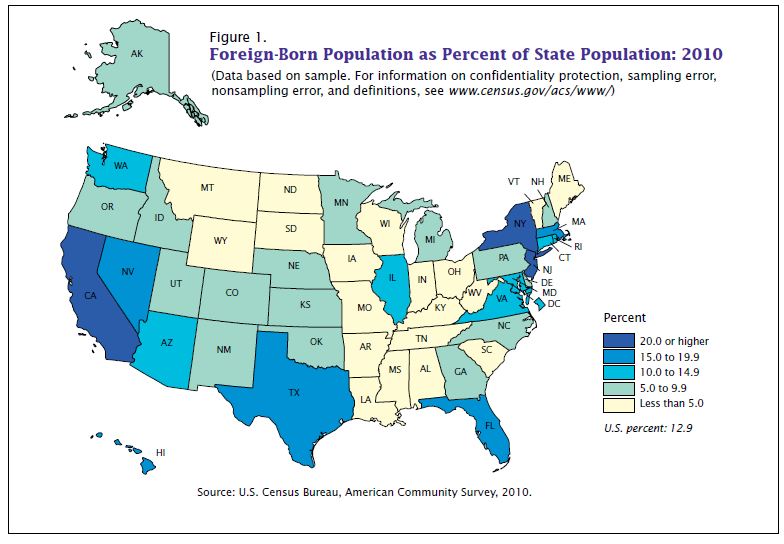 The U. S. Census Bureau recently released the numbers on the foreign-born population. You will want to read the full pdf HERE.
The U. S. Census Bureau recently released the numbers on the foreign-born population. You will want to read the full pdf HERE.
The Lord has brought the nations to this nation. How will the Church respond as a faithful and wise steward at this moment in history? Do we:
- Recognize that there are at least 361 unreached people groups in the United States?
- Recognize that there are many Kingdom citizens who have migrated to the United States?
We have been provided a wonderful opportunity to reach the world from our backyards. We have been provided a wonderful opportunity to partner with brothers and sisters from across the globe to reach the nations.
How will we respond?
Consider this information taken from the Census Bureau’s findings (linked above):
- The foreign born represented 13 percent of the U.S. population. By state, the percentage of foreign born ranged from just over 1 percent in West Virginia to 27 percent in California.
- The states with the highest percentage of foreign born in their populations were California (27 percent), New York (22 percent), and New Jersey (21 percent).
- In 2010, more than 1 in 4 foreign-born residents lived in California.
- New York, Texas, and Florida accounted for 30 percent of the foreign-born population. Including California, these four states were home to more than half of all foreign born.
- Half of the foreign born were between the ages of 18 and 44, compared with about one-third of the native born.
- Over 80 percent of the foreign born population was between the ages of 18 to 64, including 50 percent between the ages of 18 to 44. Among the native born, 60 percent were between the ages of 18 to 64, including 35 percent between 18 and 44.
- The native population had a higher proportion under the age of 18 than the foreign-born population. About 27 percent of the native population was under age 18, compared with 7 percent of the foreign born. This difference reflects the fact that children of immigrants born in the United States are, by definition, native.
- In 2010, 58 percent of the foreign born aged 15 and older were married, while 26 percent were never married. By comparison, the native born aged 15 and older were less likely to be married (47 percent) and more likely to never have been married (33 percent). However, the native born were more likely to be separated or divorced (14 percent) than the foreign born (11 percent).
- Over 2 of every 5 foreign born were naturalized citizens.
- More than three-fourths (77 percent) of foreign-born households and almost two thirds (65 percent) of native households were family households.
- The average size of foreign born households (3.4 persons) was larger than that of native households (2.5 persons). One reason for this difference is that a higher proportion of foreign-born family households (62 percent) than native-born family households (47 percent) included children under the age of 18.
- Half of all foreign born either spoke only English at home or spoke a language other than English at home and spoke English “very well.”
- About 85 percent of the foreign-born population spoke a language other than English at home, compared with about 10 percent of the native population.
- One in ten foreign born did not speak English at all.
- The foreign born were more likely than the native born to work in service, construction, and production jobs.
- The median household income of foreign-born households in the 12 months prior to being surveyed was $46,224, compared with $50,541 for native households. The difference in income was larger when focusing only on family households: the median income was $62,358 for families with a native householder and $49,785 for families with a foreign-born householder.
- About 19 percent of the foreign born were living below the poverty level in the 12 months prior to being surveyed, compared with about 15 percent of the native born.
These are just a few of our realities.
How will we respond? What are the Kingdom opportunities? Where are the bridges and barriers to the gospel spreading rapidly and with honor (2 Thes 3:1) across the nations in this nation?
If you have not had a chance to check out the booklet “Scattered to Gather”, I want to encourage you to take a look at it. It is an excellent resource about the nations on the move. You may find it HERE. Also, you may find my book Strangers Next Door: Immigration, Migration, and Mission to be of some assistance to you as well.
(image source: U.S. Census Bureau)

JD, you report that there are 361 UPG’s in the USA which varies from what the Joshua Project reports at 68. I have no doubt that the number is higher than what JP is reporting but do you have a list of the 361? If so, how can I obtain a copy of that list?
Brian,
That is the number that was reported (as of about a month ago) from the Global Research Department, International Mission Board. Go here: http://www.peoplegroups.org/ and then view GSEC Monthly Reports.
J. D.
Thanks, JD, got it
After reviewing the IMB UPG data they actually list 394 UPG’s in the U.S. By Evangelical status they are:
0 – 5 – No evangelical Christians or churches.
1 – 360 – Less than 2% Evangelical. No church planting
2 – 29 – Less than 2% Evangelical.Initial church planting begun.